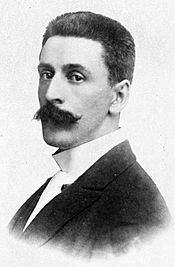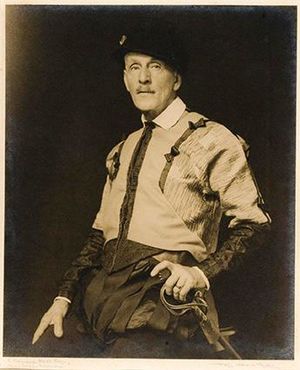Lindsay Bernard Hall facts for kids
Quick facts for kids
Lindsay Bernard Hall
|
|
|---|---|
 |
|
| Born | 28 December 1859 Garston, Liverpool, England
|
| Died | 14 February 1935 (aged 75) London, England
|
| Resting place | Golders Green Cemetery, London |
| Nationality | British/Australian |
| Known for | Director, National Gallery of Victoria (43 years) |
| Spouse(s) | Elsinore Mary Shuter; Harriet Grace Thomson |
| Signature | |
 |
|
Lindsay Bernard Hall (born December 28, 1859 – died February 14, 1935) was an amazing artist, teacher, and director of an art gallery. He was born in England but became a famous Australian figure in the art world.
Contents
Early Life and Art Training
Lindsay Bernard Hall was born in Garston, Liverpool, England. His father was a broker, and his family had a connection to Captain Basil Hall, a famous travel writer. Lindsay's grandfather was J. Z. Herrmann, a well-known music conductor.
Lindsay grew up in a very cultured home. He went to Cheltenham College for his education. After school, he decided to study painting. He learned art at the South Kensington School of Art in London. He also studied in other European cities like Antwerp and Munich.
After finishing his studies, he worked as an artist in London for several years. He even showed his paintings at the famous Royal Academy. He was also one of the first members of the New English Art Club. He exhibited his art with this club in 1886 and 1887.
Leading the National Gallery of Victoria
In 1891, a big opportunity came up for Lindsay. The director of the National Gallery of Victoria in Melbourne, Australia, passed away. Lindsay Bernard Hall was chosen to take his place. He also became the head teacher at the National Gallery of Victoria Art School.
He started his new job in March 1892. This was a huge role, and he held it for 43 years! Many of Australia's most famous painters learned from him at the art school.
In 1894, Lindsay married Elsinore Mary Shuter. Sadly, she passed away in 1901.
Lindsay also helped the gallery decide which artworks to buy. In 1904, the gallery received a very generous gift of money from Alfred Felton. This meant Lindsay had even more responsibility. In 1905, he traveled to England to buy art for the gallery using this special fund.
When he returned, he had to advise on all kinds of art and objects for the museum. Even though he wasn't an expert in everything, he studied hard. He made very few mistakes when choosing new pieces for the collection.
His Art and Influence
Lindsay Bernard Hall was a busy man. Being a director and adviser took up most of his time. This meant he could only paint on weekends and during his holidays. He often showed his work at exhibitions held by the Victorian Artists Society. He also had his own art shows.
In 1912, Lindsay married for a second time to Harriet Grace Thomson. He had one son from his first marriage and two sons and a daughter with Harriet. They all survived him.
Lindsay was a tall and distinguished man. He was always polite but had strong beliefs. He was quite traditional in his art and his views on life. One interesting thing about him was his strong belief that William Shakespeare might not have written all of his famous plays. He thought someone else, like Francis Bacon, might have been the real author.
He was very honest about his opinions on art. He didn't see much value in what was called "modern art" at the time. He felt it didn't follow the basic rules of art. His own paintings were always carefully planned and very well drawn.
You can see examples of his work in galleries in Melbourne, Sydney, and Adelaide. These paintings show that he was a very skilled and dedicated artist.
As a teacher, some students found him a bit distant at first. This was probably because he was a little shy. But he became warmer as he got older. People had different ideas about his teaching style. However, many famous artists learned from him. His focus on being honest, truthful, and good at drawing was very helpful to his students. Lindsay Bernard Hall's personality had a big positive impact on art during his time.
Death and Legacy
In February 1934, Lindsay went to London again to advise the Felton trustees on art purchases. He passed away there on February 14, 1935. He was buried at Golders Green cemetery in London.
Many people attended his funeral. These included Australian artists like George Bell, James Quinn, and Bess Tait. British sculptors Gilbert Bayes and Lady Hilton Young were also there.
Images for kids
-
Edmund la Touche Armstrong, painted around 1925 by Lindsay Bernard Hall. This portrait is at the State Library of Victoria.
-
The Quest, painted around 1905 by Lindsay Bernard Hall. This artwork is part of the collection at the National Gallery of Australia.




